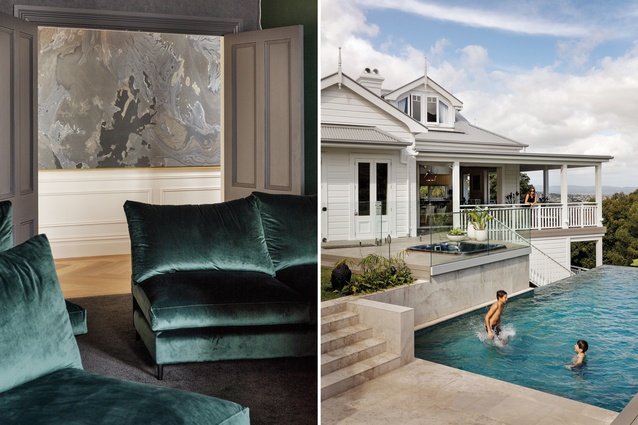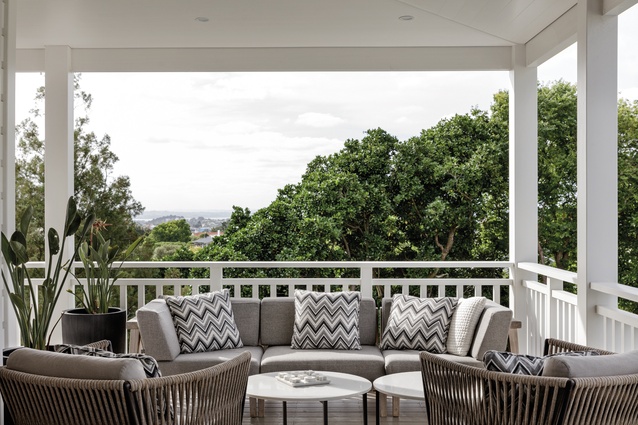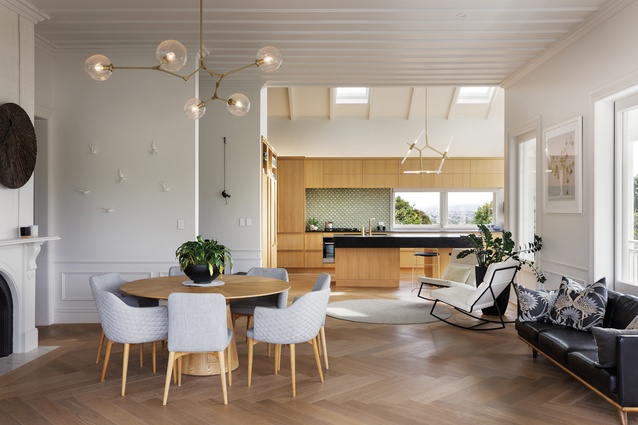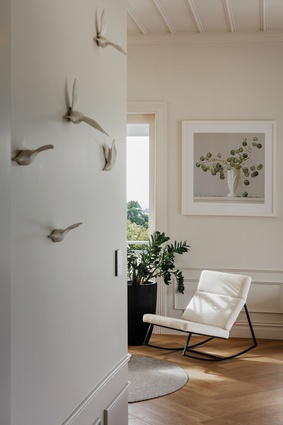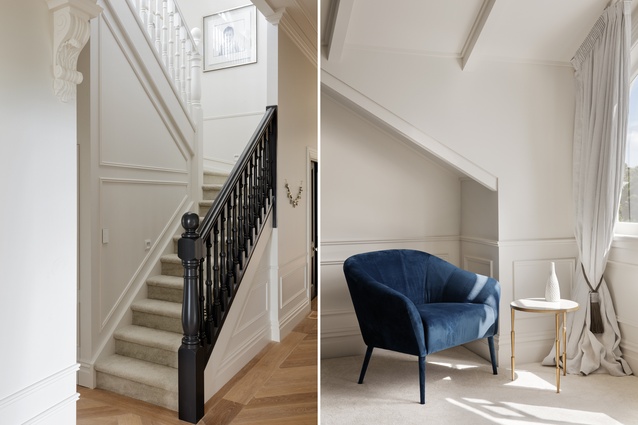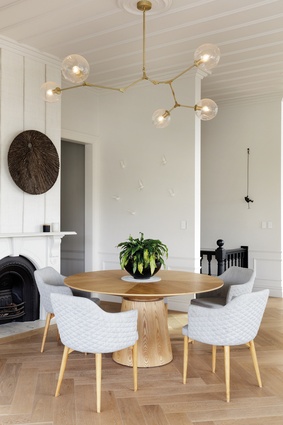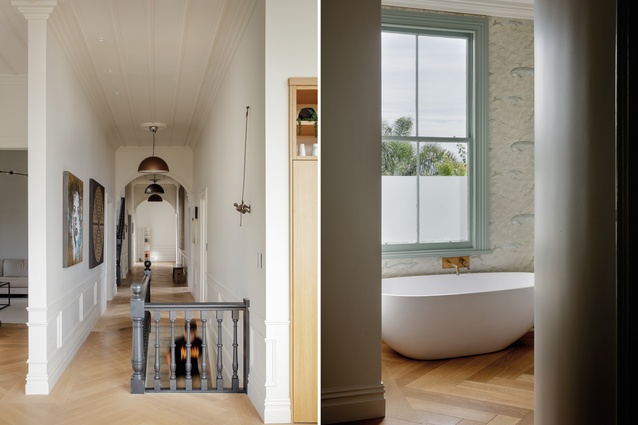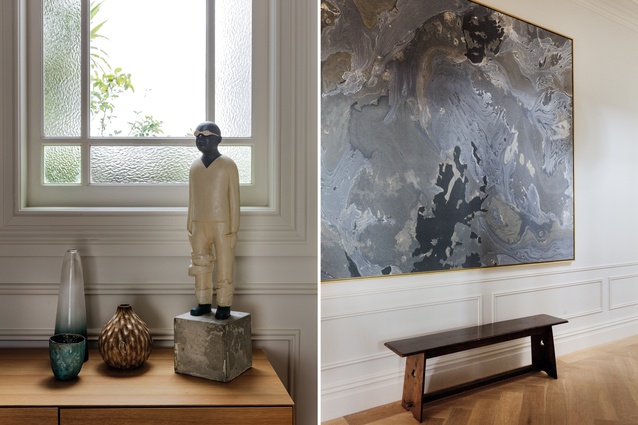Enduring: Mount Eden House
The homeowner and designer of this Mt. Eden renovation has created a new history for her family in a home that was built in 1862.
Where the girls in the Gray family once sat on the front verandah darning, knitting and chewing the breeze (back in the 1860s), now, Rachyl and Tony Abraham, and their three children – Charlotte (15), Gabriella (13) and Daniel (10) – enjoy weekend breakfasts at a specially designed window bar that overlooks leafy suburbia through to the Waitakeres. Although needlework has been relegated to the annals of history, and the view from this hilltop eyrie has changed, the house itself, built in 1862, remains just as special as it was.
“A lovely old neighbour told us many stories about the Grays,” says Rachyl. “He said they had a view of the quarry and of Coldicutt, the original stone house on Mt Eden Road.” Those were the days when all grand houses were given names and, when the Abrahams bought here three years ago, there was a plaque that read ‘Ellamore’ screwed to the front entry.
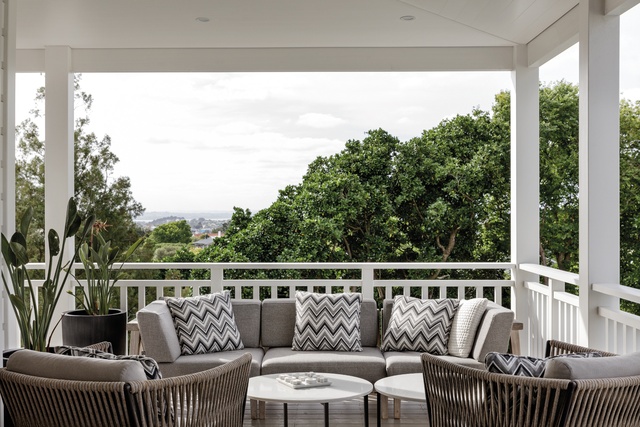
Rachyl, a spatial and interior designer, had always said that, if they could find a Mount Eden property in a cul-de-sac, facing west and with views, they’d move from their villa; they found such place at Ellamore.
Over two levels and with quaint, cottagey looks, including wrought-iron balustrading and a country garden, it was a pretty place. Inside, the previous owner had painted it creamy yellow. There were chequerboard hearths and swagged burgundy drapes.
Rachyl was keen to be sensitive to the rich history of the place while keeping the space flexible and practical enough to make this their forever home. “I’m passionate about achieving a modern slant without taking all the character out.” This is not to say it was as the Victorian architect intended. It wasn’t. A succession of owners had tinkered with the structure and the house already had a voluminous extension – a country-style kitchen with a cathedral roof.

Unlike most cottages, it had a beautiful high stud but, like most homes of the era, it seemed to suffer from an illogical layout, including bedrooms facing north to the view while the kitchen was located down the back of the house.
A year and a half of project-managed chaos ensued; the many rooms – and family members – played a grown-up version of musical chairs. The boot room became the entrance. A lean-to was converted to a bedroom for Daniel and the lounge to a guest bedroom.
One bedroom became the guest bathroom; two more were knocked through for the open-plan kitchen/living area. And so on and so on and so on. Finally, a third level was added – an upstairs master suite.
Through it, all the Abrahams shifted spaces, hiring a cabin as a sleepout and decamping to the studio (now a pool house) that was part of the property. “It was really good for the kids,” says Rachyl. “They now have a much better appreciation of ‘home’.”
Because she studied design in Chelsea, London, and has worked overseas, Rachyl has transatlantic taste. Double doors at the entrance remind her of the Brooklyn brownstones while the French oak floors, laid in a herringbone pattern, could be straight out of a Parisian apartment. The couple is also well travelled, and the risk was that a hodgepodge of cultural references could juxtapose and jar. Not a chance.

Rachyl’s talent is to tie together African, Asian and European finds seamlessly. The chalky-white backdrop of Aalto ‘Align’ paint was a good start. “With such big spaces, I needed a white that was subtle and restful, and tied in with the slight limewash on the floors. Then I brought in depth by using deep blues and grey on the doors and accent areas.”
Although the house is undoubtedly stylish with many modern moves, underpinning it all is a case for comfort. The kitchen has warm timber cabinetry and a practical scullery, complete with oven, where the couple’s daughters retreat to experiment with Asian fusion dumplings and their latest fad: smoothie bowls. “I call it a ‘gentle’ kitchen.
I could have designed the space to be far more dramatic but this is a hub for family, after all.” The granite island bench has been given a leathered finish. “The minute I saw it, I knew I wanted it. It’s very forgiving and the natural grain still shows through.”
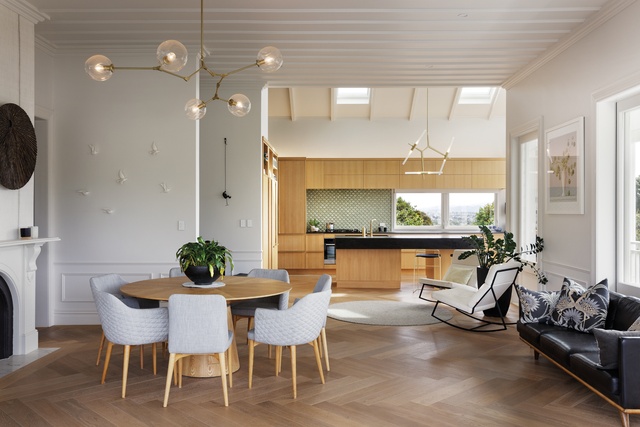
A secret door in the cabinetry leads downstairs to a wine cellar and off this is a cluttered workshop where Dan, the couple’s youngest, can build his creations. “He’s always tinkering,” says Rachyl. A skateboard primed for action with skate shoes glued to the perfect spot ready for riding is just one of his inventions.
Also downstairs, a flat that was rented out during World War II has, incongruously, become a teen-queen haven. The girls may share a bathroom but their rooms also share a balcony, which has direct access to the swimming pool. “The spatial design has been done with the future in mind – there is just enough separation between the teenagers and the adults,” says Rachyl.
Rachyl is proud of the fact that she has navigated the needs of everyone in residence, collaborating when required (Gabriella vetoed a wallpaper because it was ‘too girly’) while putting her foot down as necessary (she’s trained her crew to retrieve their washing from cubbies in the laundry – and no more is done until these are emptied).
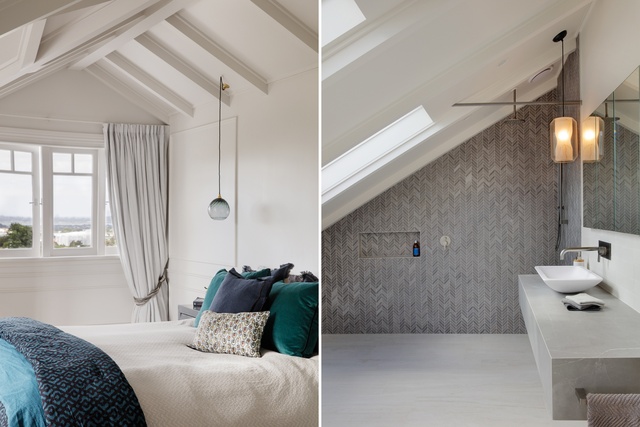
But what she’s most proud of is that, as the renovation unfolded, it was clear that she’d managed to capture a view in every room – from red sunsets over the Waitakere Ranges in the kitchen to a twinkle of lights on the Manukau Harbour, through a carefully positioned casement at the entrance, or the vivid volcanic bulk of Mount Eden framed by the bedroom sliders – it’s a wraparound experience. The Gray family would no doubt have approved.
Q&A with Rachyl Abraham, owner of Tesori Design
When and how did your design business begin?
I studied spatial and furniture design as part of my design course in London and, when I returned to New Zealand, I designed a range of children’s furniture. That business grew so quickly that I found it difficult to manage since I already had two toddlers. So I sold it to Criterion Furniture, who took it offshore. I then focused on interior projects, mainly in the residential sector.

Tesori has been going for 16 years now; how has it evolved?
People often say I have a good ability to interpret how space should be or could be used in homes and I thrive on getting the most out of the requirements for a particular zone or space. I’ve moved into a kind of middle ground between architect and interior designer.
These days, I work with clients to help tease out briefs for their architects. Many people are swayed by fashion and don’t know what they genuinely like – or why – and don’t consider what the future will bring. I work with them to explore these options and push boundaries. Then I liaise with the architects, get involved with the interior design within the main areas of the home and, sometimes, even end up project-managing jobs for clients.
What are your ‘golden rules’ of design?
Take heed of the things you like but be practical about it. Young children grow up to be teenagers with different needs, chefs and great entertainers require something different from a kitchen than do keen home cooks and, if you’re into hunting or fishing, don’t try to squeeze the laundry into a cupboard. However, never forget there is always a place for ‘form over function’.
What has been a favourite part of redesigning and decorating this home?
The chance to buy lots and lots of lighting! To me, lighting is like jewellery and I’m a magpie drawn to it. I think lighting can transform a space and if I can’t put my latest find into my own home, watch out – because I’ll definitely put it into my clients’.

